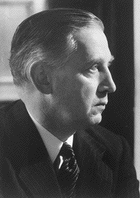Edward V. Appleton
- Birthdate
- 1892/09/06
- Birthplace
- Bradford, England, UK
- Death date
- 1965/04/21
- Fields of study
- Radar
- Awards
- Nobel Prize in Physics, U. S. Medal of Merit, Norwegian Cross of Freedom, IRE Medal of Honor
Biography
Edward V. Appleton, was born on 6 September 1892, in Bradford, England. He studied under Sir J. J. Thomson and Lord Rutherford at St. John's College, Cambridge University. After participation in World War I, he returned to Cambridge and devoted himself to research on radio waves. In 1920 he was appointed Assistant Demonstrator in Experimental Physics at the Cavendish Laboratory. Two years later he became Sub-Lector at Trinity College. He received the D.Sc. degree from the University of London and became Wheatstone Professor of Physics there in 1924. In 1936 he returned to Cambridge as Jacksonian Professor of Natural Philosophy and, in 1939, was appointed to the post of Secretary of the Department of Scientific and Industrial Research, the senior British Government post concerned with physical science.
Ionosphere Experiments and Radar
In 1924 Appleton began a series of experiments which proved the existence of the ionosphere, a layer in the upper atmosphere. With the cooperation of the BBC, he applied FM to the Bournemouth transmitter and observed a beat between the signal reflected from what he later called the E layer and the outgoing signal, thus proving conclusively the existence of the ionosphere, as well as measuring its height. In 1926 he discovered an upper layer which he subsequently called the F layer (which is also known as the Appleton layer.) It is this layer, unaffected by atmospheric conditions, that allows the transmission of short wave radio around the world.
Appleton’s findings had direct value to the British military during World War II. In a famous publication in 1932, he set forth the now classical magneto-ionic theory which quantitatively describes radio-wave propagation in the ionosphere. Further research provided the basis of the technique developed for aircraft detection. Sir Robert Watson-Watt has stated that, but for the scientific work of Appleton, radar would have come too late to have been a decisive influence in the Battle of Britain.
Even through the administrative phase of his life, Appleton continued to perform ionospheric research and to publish frequent accounts of new work. He produced more than one hundred contributions to the literature on the ionosphere, not to mention numerous contributions in other fields, and was the Editor of the Journal of Atmospheric and Terrestrial Physics. He retired from the Secretaryship of the Department of Scientific and Industrial Research in 1949 to return to the academic field, as Principal and Vice Chancellor of the University of Edinburgh, a position he held for the rest of his life.
Awards and Legacy
Appleton was the recipient of numerous awards, including the Nobel Prize for Physics, the U. S. Medal of Merit, the Norwegian Cross of Freedom, and appointment to the French Legion of Honor and to the Pontifical Academy of Science. He was an IRE Fellow (1931) and in 1962 received the IRE Medal of Honor, "for his distinguished pioneer work in investigating the ionosphere by means of radio waves."
He was married to married Jessie, the daughter of the Rev. J. Longson, and they had two daughters. He passed away on 21 April 1965.
